Review of the Sabrent Rocket 4 Plus PCIe Gen 4 NVMe SSD
2021 has been a real boom year for super-fast SSD storage and one drive that has seemingly come out of nowhere to being EVERYWHERE is the Sabrent Rocket 4 Plus SSD. Although it could be argued that many areas of consumer technology has stagnated during the pandemic in terms of research and development, solid-state drives (SSDs) have gone from strength to strength and this year we have seen some of the biggest and fastest evolutions in this technology arrive in front of consumers worldwide, with few creating the same waves of surprise of the Sabrent Rocket 4 Plus! Sabrent, who was once better known for their enclosures and docking stations, a few years ago go to made big moves into their own range of affordable yet high performing PCIe4 SSD and their latest release has really thrown a cat among the bigger pigeons of Samsung, WD and Seagate. Arriving with the new cutting edge Phison 18 controller, Micron 96 layer 3D TLC NAND and PCIe Gen 4 x4 architecture, it is easy to see why this comparatively unheard of brand in SSD has got a lot to shout about. This has increased considerably now that the PS5 Storage Upgrade update is available to many users and the Sabrent Rocket 4 Plus is fully compatible, leading to many users comparing this drive against the Samsung 980 Pro, WD Black SN850 and Seagate Firecuda 530 for their big console upgrade! Today we want to talk about what you get for your money, what the Sabrent Rocket 4 Plus can do and what it can’t do. Let’s find out if the Sabrent Rocket 4 Plus deserves your data.
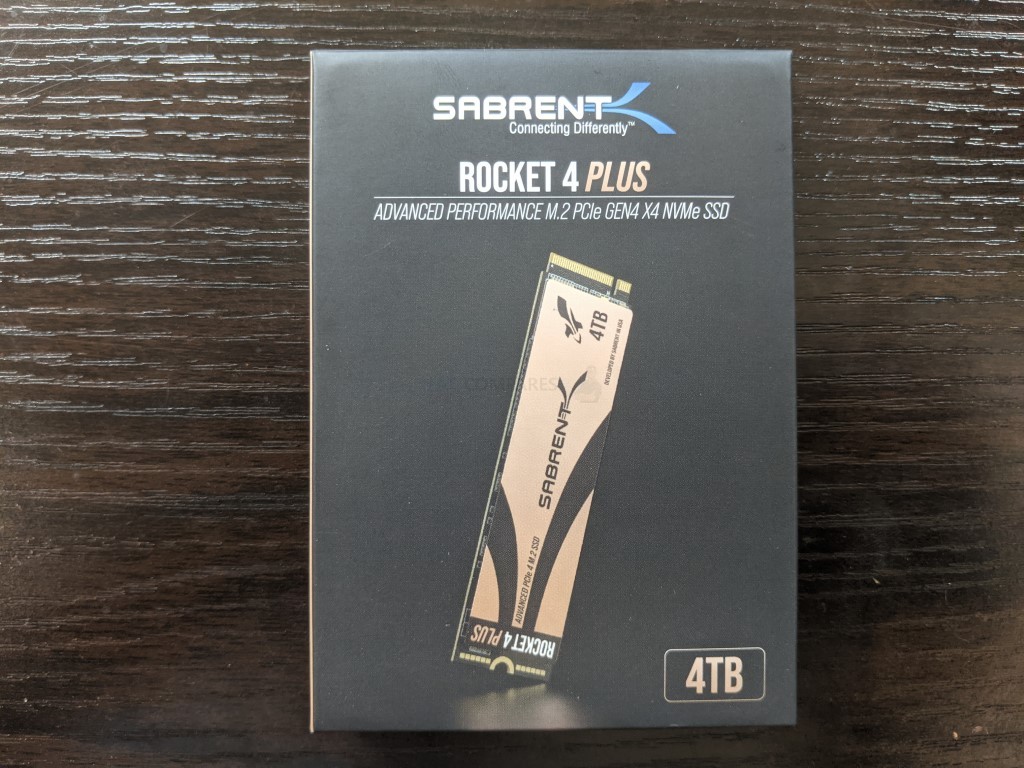
Sabrent Rocket 4 Plus SSD Review – Quick Conclusion
The Sabrent Rocket 4 Plus is not a drive that exaggerates on its spec sheets. With a number of new PCIe 4 M2 SSD arriving throughout 2021, you could easily assume that this SSD and its comparatively short pedigree in the solid-state drive industry when compared against giants like Samsung and Seagate, would get lost in the noise. I’m pleased to confirm that the Rocket 4 Plus is as high-performing as the brand states and now it has appeared on the PS5 SSD compatible storage list, is definitely worth checking out. It is by no means perfect, with reported IOPS noticeably lower than its competitors in the 980 Pro and Firecuda 530, as well as a noticeable price increase over the previous generation SSDs (somewhat unavoidable I guess), the Rocket 4 Plus may seem like something of a gamble for those who who have remained brand loyal with longer-established brands till now. However the performance of this SSD more than justified its existence and as long as you are prepared to overlook a rather awkward warranty registration hurdle, I can certainly recommend the Sabrent Rocket 4 Plus for PC Gamers, Video Editing Professionals and Playstation 5 Console Upgrades in 2021/2022.
| PROs of the Sabrent Rocket 4 Plus | CONs of the Sabrent Rocket 4 Plus |
| Genuinely Impressive Performance
One of the Affordable 7,000MB/s Drive on the Market PS5 Compatibility Confirmed Decent Amount of DDR4 Memory Cache 96 Layer 3D TLC NAND Hugely Beneficial One of the Earliest Phison E18 SSDs Surpasses Samsung/WD PCIe 4 SSDs in some key areas |
IOPS rating is noticeably lower than most competitors
Endurance (DWPD/TBW) has dipped noticeably since it’s predecessor Still Outperformed by the Firecuda 530 Warranty (1yr unless registered) seems needlessly complex |
Sabrent Rocket 4 Plus SSD Review – Packaging
When Sabrent sent me the Rocket 4 Plus SSD, one of the first things that struck me was that the retail box is absolutely tiny. I know that should not come as a big surprise given how small formed factor m2 actually is, but even in 2021, these drive will typically arrived in boxes 3 or even for times this size and normally because they include additional manuals, as well as structured packaging that ensures that SSD is projected in transit. So the fact that this £1,000 SSD arrived in a box this small definitely gave me pause for thought.
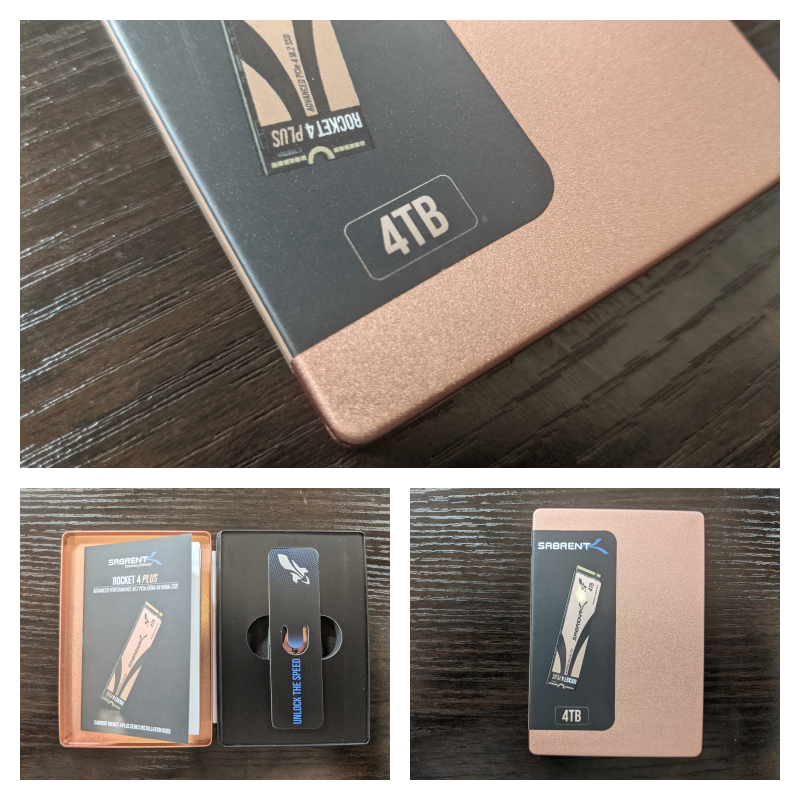
However, my fears were immediately put to rest as soon as I opened the box and found that the Rocket 4 Plus SSD arrives in a rather smart looking metal hinged box casing. This rose gold packaging contained the SSD, surrounding pre-cut foam and installation guide. This was definitely a nice touch and certainly a step up in presentation when compared to do numerous other m2.SSD reviewed in the past.
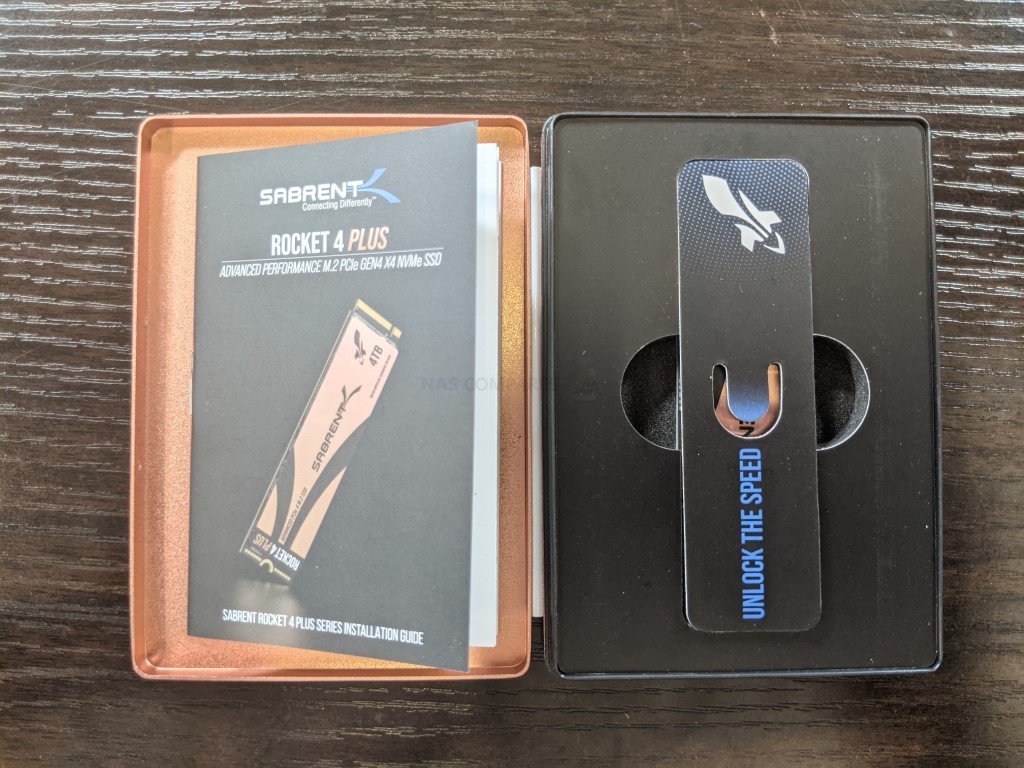
Important – The photos for this review were taken AFTER the video review took place. I wanted to highlight this as during the video review I removed the adhesive labels on either side of the SSD in order to show the individual components onboard. This has resulted in the branded label and metallic front panel being less flush than it was when the drive was originally received and I take full responsibility for this. In particular, the metal panel was a great deal smoother before I got my grubby paws all over it.
The front logo display label on this SSD is actually quite a sturdy metallic panel that covers a number of key PCB components. This again is something I have not really seen any other brand do and although it is by no means industrial in quality, still quite impressed with this neat little design touch and I would argue assisted heat dissipation a tad too.
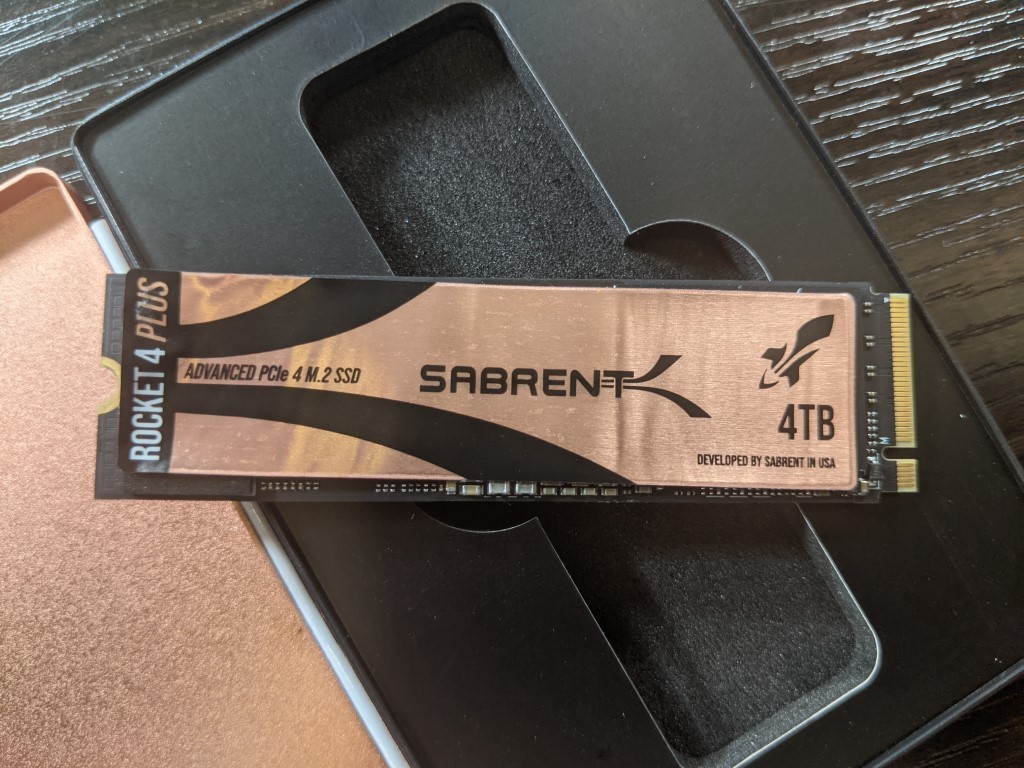
The other side is a little more mainstream and features A branded and model identifying sticker for this SSD. It is worth highlighting that removing either of these labels will result in the SSD potentially avoiding it warranty due to tampering, so although I am going to remove these labels 2 to give you a better look at the controller, NAND and other components, I do not recommend you do this.
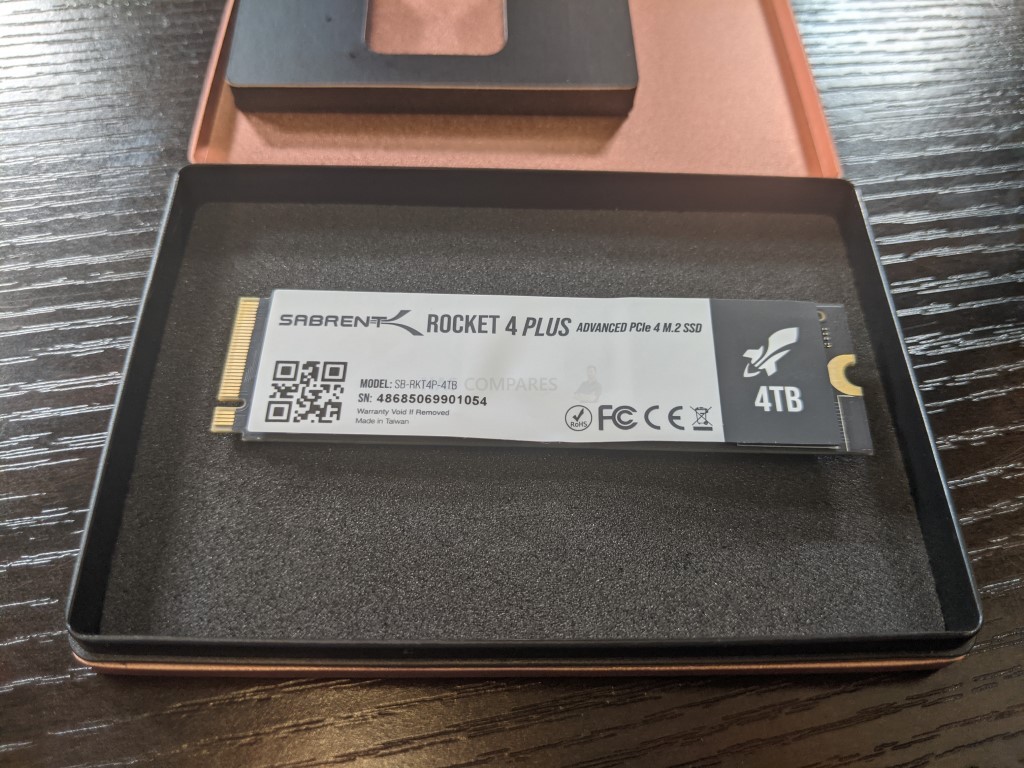
As the model being reviewed today is the 4TB (4000GB) Rocket 4 Plus Sabrent SSD, it is worth highlighting that this is a double-sided SSD. This should definitely be a factor for those who wish to utilise additional keep thermal padding and heatsinks around this SSD in their PC, NAS or PS5 systems. Indeed, there is an additional high-quality sync available to ensure this Drive maintains optimal operational temperatures in your system for around £25. However this heatsink raises the height of the M.2 connector a couple of millimetres, so be aware (mainly PS5 owners)
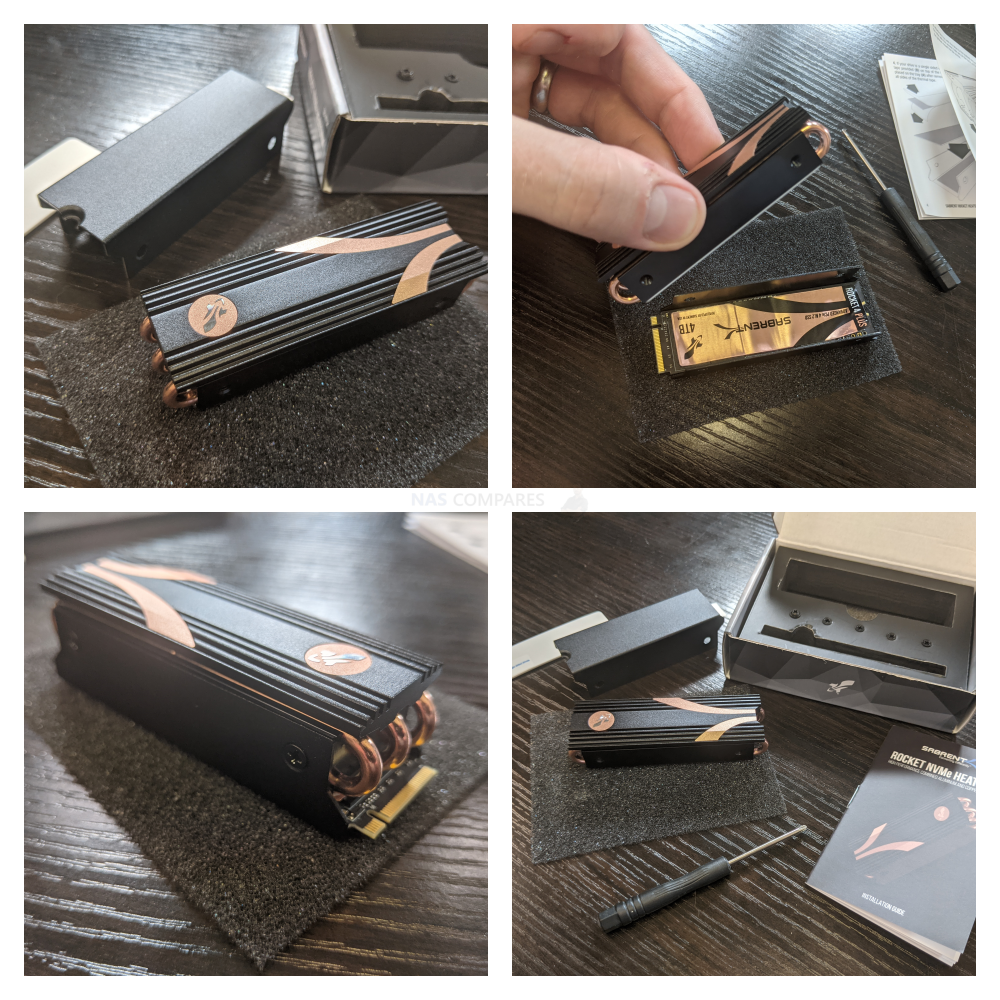
The storage NAND, Phison E18 controller and DDR4 memory that this Drive arrives with as are well distributed on either side of this SSD and you are not left feeling like this is a cheap, sub-brand product. Let’s take a moment to have a closer look at the key SSD components that help this SSD break the proposed 7,000MB/s Sequential Read barrier.
Sabrent Rocket 4 Plus SSD Review – Hardware Specifications
Given the length of time that the Sabrent Rocket 4 Plus has been available (since March/April 2021), it is very surprising how similar the hardware it features compares to SSDs released in the last few months (such as the MSI M480, Gigabyte AORUS 7000s and Corsair MP600). iNDEED, Sabrent were one of the very first PCIe 4 M.2 SSDs on the market to take advantage of the Phison E18-PS5018 high-end controller. Alongside this, they are using noticeably denser NAND than many others and are even one of the very very M.2 PCIe SSD on the market right now at 2280 length available in 4TB (which most capping at 2TB). Let’s take a look at the architecture of the range:
| SABRENT Rocket 4 + | 
SB-RKT4P-1TB |

SB-RKT4P-2TB |

SB-RKT4P-4TB |
| PCIe Generation | PCIe Gen 4 | PCIe Gen 4 | PCIe Gen 4 |
| NVMe Rev | NVMe 1.4 | NVMe 1.4 | NVMe 1.4 |
| NAND | Micron B27 3D NAND 96L | Micron B27 3D NAND 96L | Micron B27 3D NAND 96L |
| Capacity | 1TB Single Sided | 2TB Double Sided | 4TB Double Sided |
| Controller | Phison E18-PS5018 | Phison E18-PS5018 | Phison E18-PS5018 |
| Memory | 1GB | 2GB | 4GB |
| Size | 2,280 | 2,280 | 2,280 |
| Warranty | 5yr | 5yr | 5yr |
I know a lot of the above will seem needlessly technical, so below we can bring the most important considerations into sharper focus.
Hardware Focus of the Sabrent 4 Rocket Plus SSD Series
The first big, BIG thing to remember here is the controller, that Phison E18. An SSD is much like a microcosm version of a whole computer. The Controller is equivalent to the CPU, and Phison are one of the bigger 3rd party SSD controller manufacturers in the world! I say 3rd party, because some long-running storage brands like Samsung and WD have most of their development and hardware engineering ‘in-house’ and use their own branded controllers. Whereas some brands source some/all components for their SSDs from 3rd parties – which is not necessarily a bad thing for both them and the industry (there are pros and cons on either side). Phison has been at the cutting edge of this subject for years now and the E18 was first revealed last year in 2020, but due to the pandemic making storage trends unpredictable and semi-conductor shortages, most SSDs that utilized the Phison E18 eventually arrived in 2021. This controller is one of the biggest reasons that the Sabrent Rocket 4 Plus can actually make it’s promises about the 7,000MB/s+ Sequential Read (sequential data = big chunks of data). However, that is not the only reason.
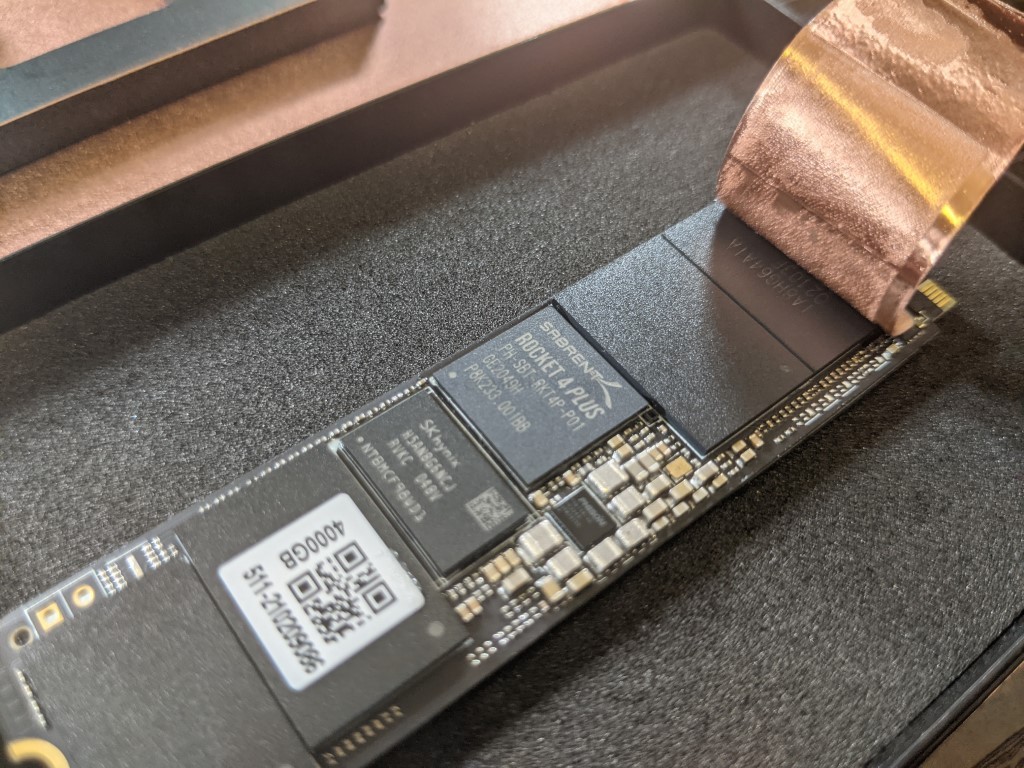
The NAND on the Sabrent Rocket 4 Plus is where the data lives! SSDs (as you no doubt know) do not use moving parts as found in traditional hard drives and instead uses cells that are charged and data is read/written to them in this process. The quality of the NAND and the layers used will make a big difference to the durability and performance of an SSD and although the Sabrent Rocket 4 Plus does not provide the best SSD in the industry at this tier right now (that, once again, goes to the Seagate Firecuda 530 at 176 layer 3D TLC NAND), it is bigger than most, arriving at 96 Layers of 3D TLC NAND. Although the majority of modern PCIe M.2 SSD use 3D TLC NAND (avoid QLC NAND like the PLAGUE btw!), most are still at 64 layers or so, so this is a big jump up for the Sabrent SSD.
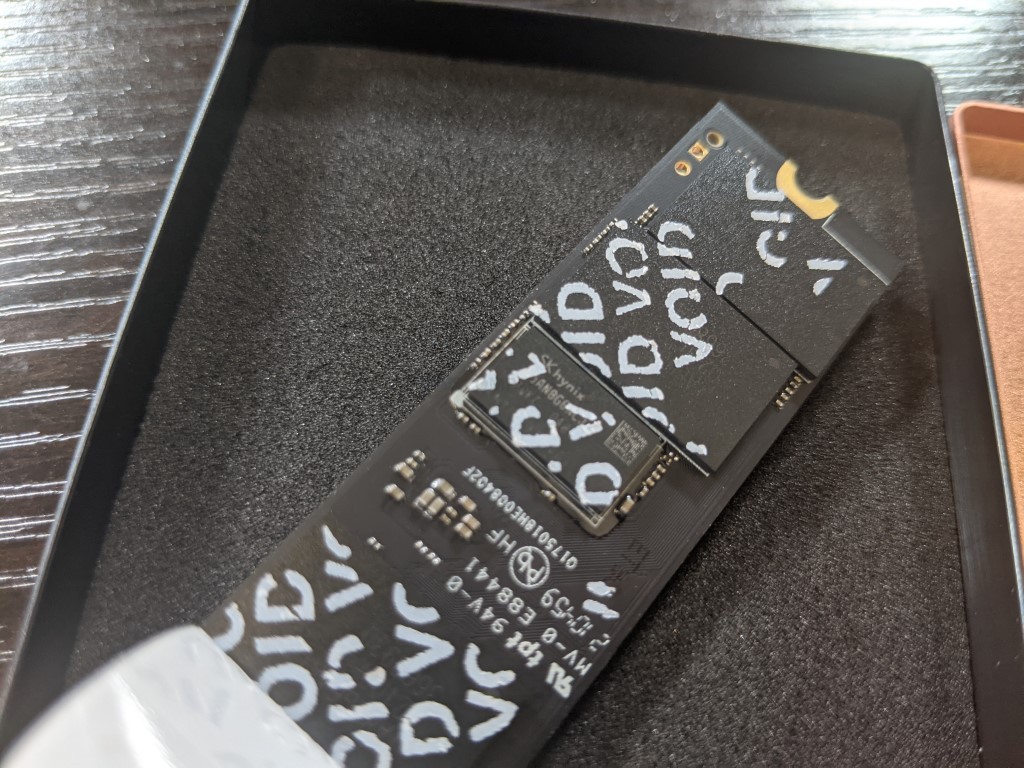
Much like the Controller on the Rocket 4 Plus being the ‘CPU’, it also has an area of memory. The Sabrent SSD uses DDR4 memory on board and this in conjunction with the SSD provides a massive body of data handling resources for getting your data moving through the SSD and out of the m.2 NVMe PCIe 4 interface. The amount of memory scales in conjunction with the 1TB, 2TB and 4TB SSD you use, but starts at an impressive 1GB of DDR4 at the lowest tier.
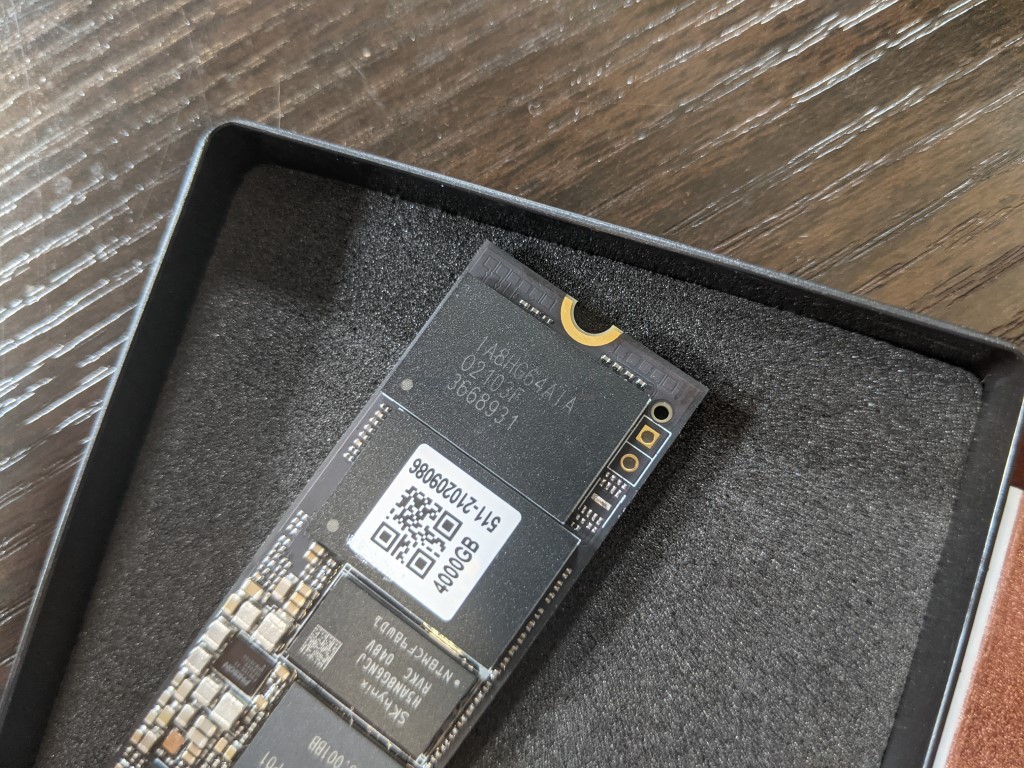
As mentioned, all three available capacities of the Sabrent Rocket 4 Plus arrive at 2280 in length. This is quite normal for the 1TB and 2TB versions, but the fact they were able to get 4TB on a 2280 SSD (and still not useless useful QLC NAND to make up the difference) is very impressive. The 2TB and 4TB models both use double-sided NAND distribution (so the cells are on either side), in order to space out the storage and allow even cooling, NAND wearing and performance. Do remember that this means you will need to provision heat dissipation on both sides of the NVMe M.2 SSD, using a metal surrounding heatsink OR thicker base level thermal heat pads.
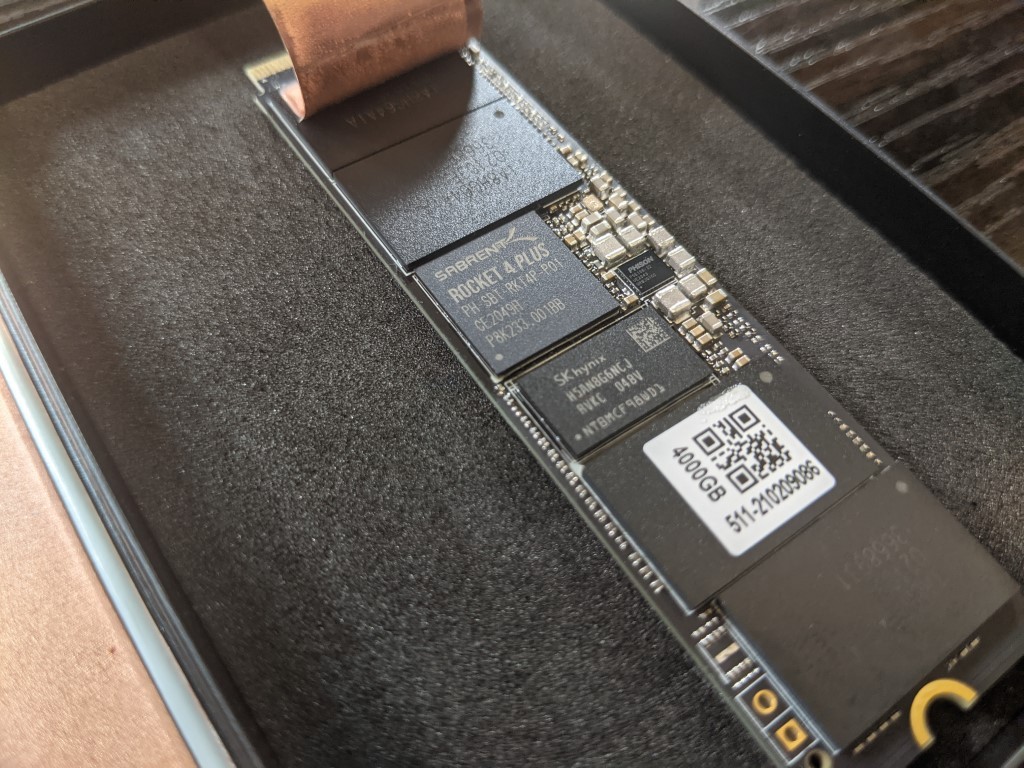
Fianlly, there is the M.2 NVMe connection. Not all m.2 SSDs are created equal and although M.2 SATA and M.2 NVMe look similar, they provide massively different performance and connectivity. However, the Sabrent Rocket 4 Plus takes it one step further, by using a newer generation of PCIe Connectivity. In short, M.2 NVMe SSDs are connected to the host PC/Console system via PCIe protocol (think of those slots that you almost always use for your graphics cards, but a much, MUCH smaller connector). These allow much larger bandwidth (ie maximum speed) for the connected storage media, Much like regular PCIe slots, they have different versions (i.E PCIe Gen 1, 2, 3, 4, etc) and also a multiplying factor (x1, x2, x4, etc). Up until around 18 months ago, the best M.2 NVMes were M.2 PCIe Gen 3×4 (so a maximum 4,000MB/s possible). However, never generation SSD like the Sabrent Rocket 4 Plus use PCIe Gen 4×4 (a potential 8,000MB/s possible) and it is only now that SSD controllers and NAND production has reached a point where it can catch up and fully saturate (i.e fill) this connection.
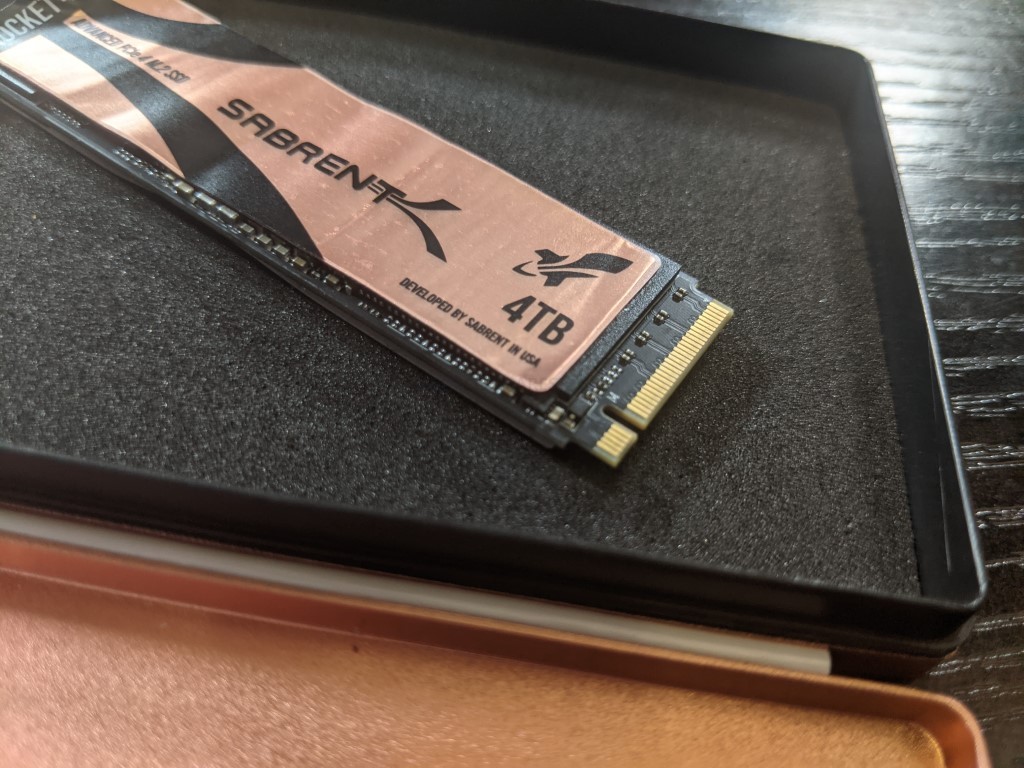
Overall, you really cannot fault the hardware inside/onboard the Sabrent Rocket 4 Plus, as it is still (4 months after release) higher performing in sequential Read and Write than many other M.2 NVMe PCIe 4 SSDs released in that time. Before we go into the full testing, however, it is worth taking a moment to look closely at the reported performance benchmarks of the Sabrent Rocket 4 Plus, as although the performance seems stellar, there are areas such as IOPS and endurance when compared with its main rivals that are worth taking into consideration.
Sabrent Rocket 4 Plus SSD Review – Official Stats First
Before we conduct our own testing on this SSD, Let’s take a closer look at the reported specifications and benchmarks first. The Sabrent Rocket 4 Plus SSD arrives in three capacities at 1TB, 2TB and 4TB. That last one is quite impressive, especially given that very few brands of M.2 NVMe SSD at 2280 arrive above. The Prices currently are a little inconsistent (with each higher capacity tier actually having a higher price per GB – quite unusual) likely due to the hardware shortages, the Pandemic and Chia have affected SSD availability in the last 12 months. Below is a breakdown of how each rocket 4 plus SSD compares:

SB-RKT4P-1TB |

SB-RKT4P-2TB |

SB-RKT4P-4TB |
|
| Price in $ and $ | $199 / £180 | $469 / £419 | $1099 / £999 |
| Total Terabytes Written (TBW) | 700TB | 1400TB | 3000TB |
| Mean Time Between Failures (MTBF, hours) | 1600000 | 1600000 | 1600000 |
| DWPD | 0.4DWPD | 0.4DWPD | 0.4DWPD |
| Random Read (Max, IOPS), 4 KB QD32 | 350000 | 650000 | 650000 |
| Random Write (Max, IOPS), 4 KB QD32 | 700000 | 700000 | 700000 |
| Sequential Read (Max, MB/s), 128 KB | 7000MB | 7100MB | 7100MB |
| Sequential Write (Max, MB/s), 128 KB | 5500MB | 6850MB | 6850MB |
There are clear throughput improvements as you rise through the capacity tiers (not unusual), as does the rated 4K IOPS. Though one area worth focusing on a little is that TBW (terabytes Written) and DWPD (Drive writes per day), as this drive is rated a pinch higher than the Samsung 980 Pro and WD Black SN850 in terms of NAND lifespan on daily writes, likely down to that Micron 96 Layer 3D TLC NAND used, rather than the 64 Layer used by competitors. This is an important point because Sabrent has previously been noted at having lower durability in earlier releases in their portfolio and this is a marked improvement.
However, despite the use of the Phison E18 controller and 96 layer NAND, the reported IOPS on each capacity is actually a noticeable degree lower than those reported by their competitors. Indeed, the Sabrent Rocket 4 Plus is the only SSD not to cross into the reported 1 Million IOPS mark, maxing out at 700k. This is still very impressive anyway, but it does make me wonder where the disparity stems from. Indeed, when you look at the bulk of PCIe 4×4 M.2 NVMe 1.4 SSD, that feature the E18 controller and 96L (or higher) on board, it really only leaves about 4 other SSDs in the market today that this can be compared against. The Corsair MP600, the MSI Spatium M480, the ADATA Gammix S70 and (current leader) the Seagate Firecuda 530. Of those, the only one that seemingly ‘out specs’ the Sabrent Rocket 4 Plus is the Seagate Firecuda 530. However, the Sabrent SSD has been available in the market for almost 5 months longer and has certainly embedded itself in the market in that time. Below is how these two drives compare:
| SSD Family/Brand |  |
 |
| 1TB Model | ZP1000GM3A013 | SB-RKT4P-1TB |
| Sequential Read (Max, MB/s), 128 KB | 7300MB | 7000MB |
| Sequential Write (Max, MB/s), 128 KB | 6000MB | 5500MB |
| 2TB Model | ZP2000GM3A013 | SB-RKT4P-2TB |
| Sequential Read (Max, MB/s), 128 KB | 7300MB | 7100MB |
| Sequential Write (Max, MB/s), 128 KB | 6900MB | 6850MB |
| 4TB Model | ZP4000GM3A013 | SB-RKT4P-4TB |
| Sequential Read (Max, MB/s), 128 KB | 7300MB | 7100MB |
| Sequential Write (Max, MB/s), 128 KB | 6900MB | 6850MB |
| 1TB Model | ZP1000GM3A013 | SB-RKT4P-1TB |
| Random Read (Max, IOPS), 4 KB QD32 | 800000 | 350000 |
| Random Write (Max, IOPS), 4 KB QD32 | 1000000 | 700000 |
| 2TB Model | ZP2000GM3A013 | SB-RKT4P-2TB |
| Random Read (Max, IOPS), 4 KB QD32 | 1,000,000 | 650000 |
| Random Write (Max, IOPS), 4 KB QD32 | 1,000,000 | 700000 |
| 4TB Model | ZP4000GM3A013 | SB-RKT4P-4TB |
| Random Read (Max, IOPS), 4 KB QD32 | 1,000,000 | 650000 |
| Random Write (Max, IOPS), 4 KB QD32 | 1,000,000 | 700000 |
| 1TB Model | ZP1000GM3A013 | SB-RKT4P-1TB |
| Total Terabytes Written (TBW) | 1275TB | 700TB |
| Mean Time Between Failures (MTBF, hours) | 1,800,000 | 1600000 |
| DWPD | 0.7DWPD | 0.4DWPD |
| 2TB Model | ZP2000GM3A013 | SB-RKT4P-2TB |
| Total Terabytes Written (TBW) | 2550TB | 1400TB |
| Mean Time Between Failures (MTBF, hours) | 1,800,000 | 1600000 |
| DWPD | 0.7DWPD | 0.4DWPD |
| 4TB Model | ZP4000GM3A013 | SB-RKT4P-4TB |
| Total Terabytes Written (TBW) | 5100TB | 3000TB |
| Mean Time Between Failures (MTBF, hours) | 1,800,000 | 1600000 |
| DWPD | 0.7DWPD | 0.4DWPD |
Yes, that is a LONG table, but you can immediately see that the Seagate Firecuda 530 raises the stakes on all of the key specifications. Although there are a number of micro reasons for this, the 176L NAND is the biggest factor here. Yes, that is why the Firecuda 530 commands the higher price tag. However, for many, the additional cost for higher durability they may never need, peak performance their core system will not reach and IOPS rating that their larger file handling will never utilize will mean that holding out for the Firecuda release is not in their interest. Both SSDs (on paper at this stage!) are fantastic examples of where consumer and prosumer SSDs are evolving towards. Let’s get the Sabrent Rocket 4 Plus on the test machine!
Testing the Sabrent Rock Plus 4TB m.2 PCIE4 NVMe SSD
The Sabrent Rocket 4 Plus 4TB was selected for this test and it was tested using multiple benchmark tools, from a cold boot, in the 2nd storage slot (i.e not the OS drive). Each test was conducted three times and an additional test was conducted on a Samsung 980 Pro 250GB and Seagate Firecuda 120 1TB SATA SSD in order to give then tests some perspective of scale (full details of this are shown in the YouTube Review of the Sabrent Rocket 4 Plus over on NASCompares):
Test Machine:
- Windows 10 Pro Desktop System
- Intel i5 11400 Rocket Lake – 6-Core 2.6/4.4Ghz
- 16GB DDR4 2666MHz Memory
- Intel B560M mATX Motherboard
- OS Storage, Seagate Firecuda 120 SSD
- Test SSD connected to Secondary PCIe Gen 4 M.2 Slot
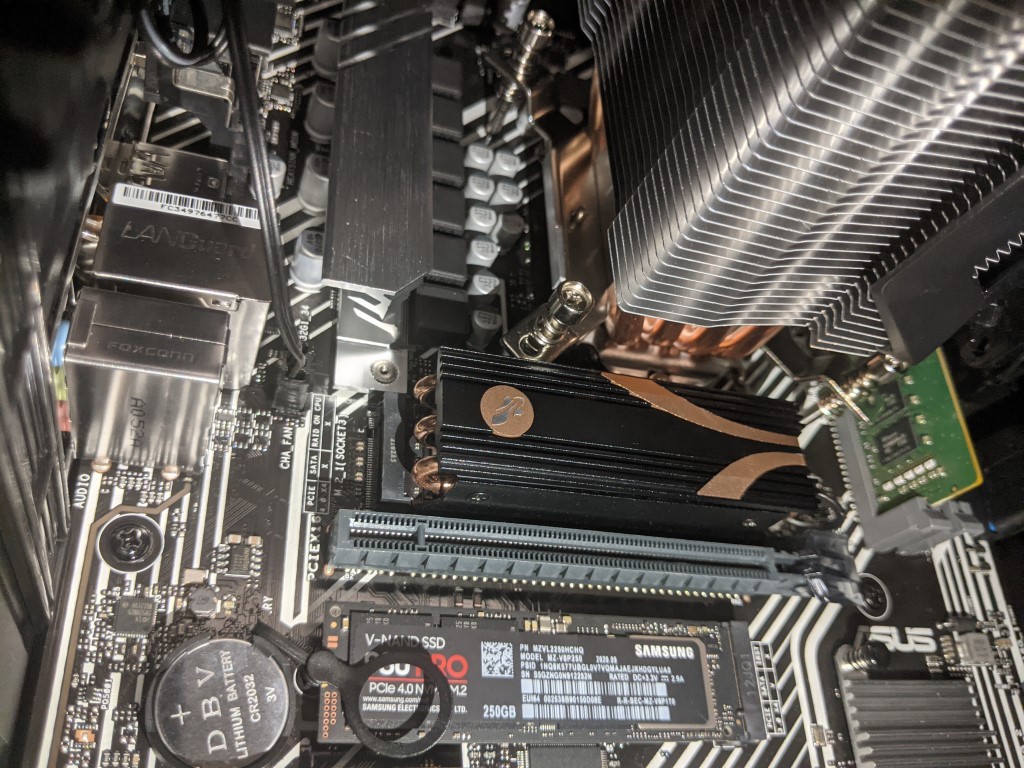
Important – It became quite clear in early testing that my test machine, despite being quite high powered, was still not quite enough to get the truest speed out of this SSD. Factors such as my OS drive being a SATA drive, capture software, embedded graphics rather than GPU card resulting in the larger graphical file testing being fractionally capped, meaning that although this drive maxed at 6,980MB/s on my system, it definitely felt that it could have gone a pinch higher and broken into the 7,000MB/s with a more powerful system. That said, these higher benchmarks are generally allied to larger/sequential data (i.e BIG single files) and you should really focus on smaller random benchmarks. I wanted to add this disclaimer.
Using CrystalDisk, we got a good measure of the drive and verified that this PCIe Gen 4 x4 SSD was indeed using the 4×4 lane. Additionally, the temp averaged out around 41C between each test being conducted.
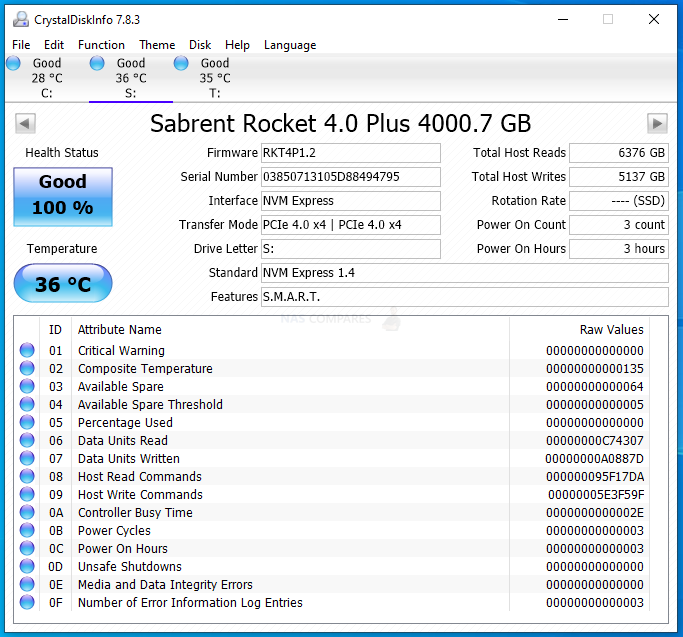
The first tests were conducted using the ATTO disk benchmark software. The first was a 256MB test file size and below is a breakdown of the transfer rates and IOPS. The Read and Write easily hit the 6,000MB/s+ area and hit 6,590MB/s Read and 6,250MB/s. However, the bottleneck of my system capped this in ATTO quite noticeably. Additionally, the IOPS benchmarks in ATTO for the Sabrent Rocket 4 Plus were good, but as expected, not breathtaking. Next, I repeated these tests with a 4GB test file.
 |
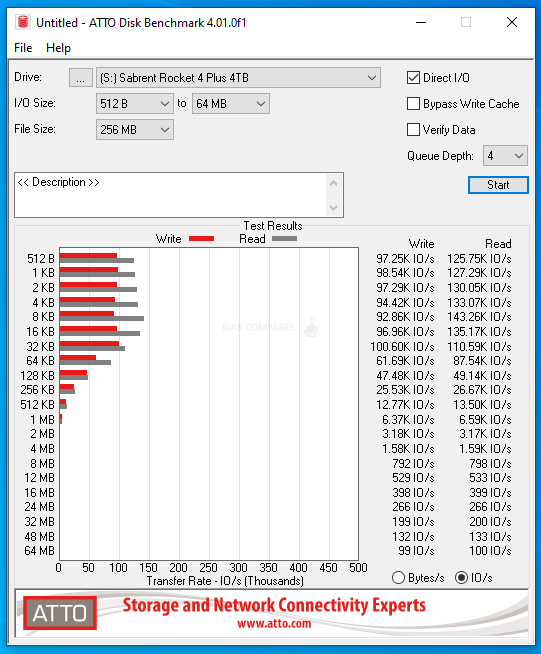 |
The larger test file, unsurprisingly, produced higher results of sequential Read/Write at 6,600MB/s and 6,300MB/s respectively. The IOPS still maintained the same level as before.
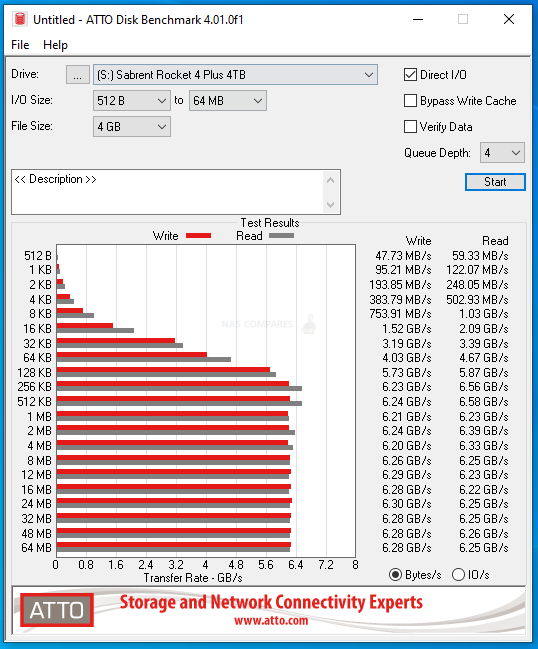 |
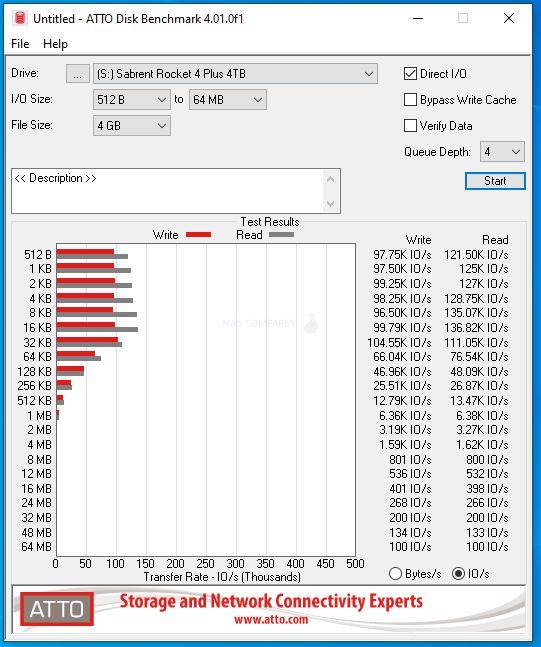 |
Next, I switched to AS SSD for benchmarks. First up was 1GB file testing, both on sequential and 4K random:
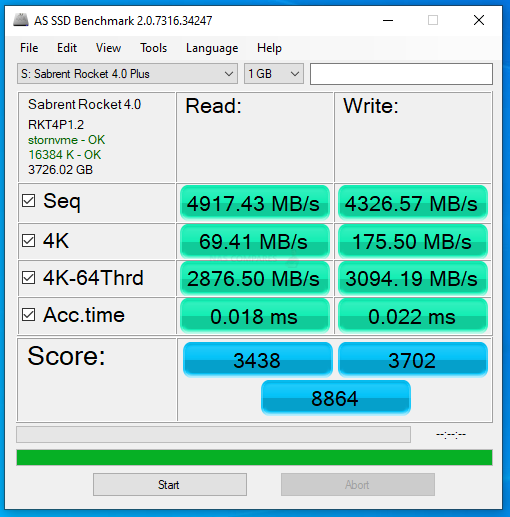 |
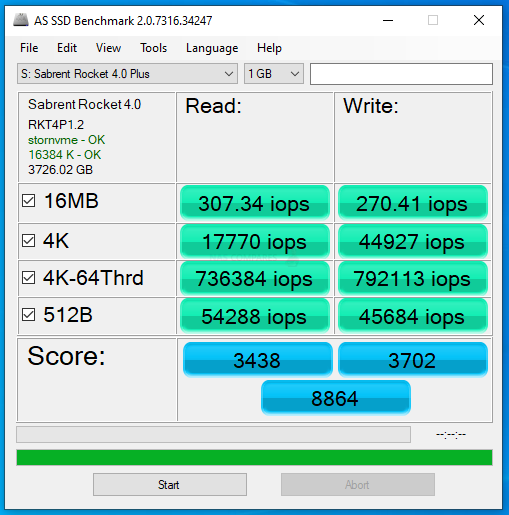 |
The results were a pinch lower than I would have liked to see, so I then moved onto the 10G test file. These were noticeably better, both in transfers and 4K random:
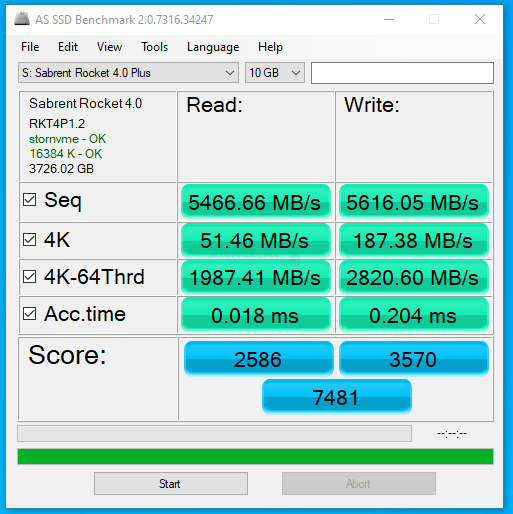 |
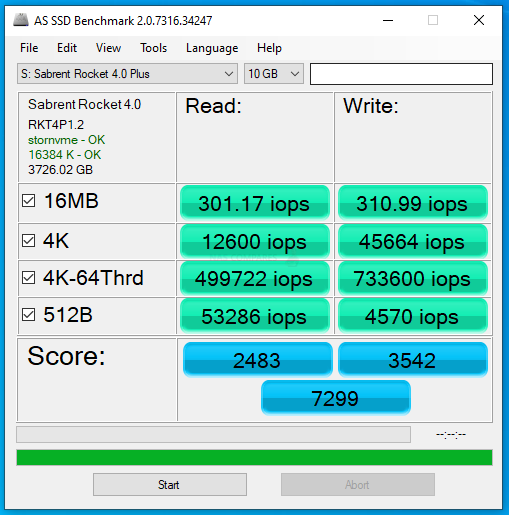 |
The AS SSD tests were quite good, but not what I would have hoped from this SSD, so I moved on to the Crystal Disk Mark testing to see how well it would handle our lasts barrage of tests. The first test was the 1GB file testing, which measured both sequential and random, as well as the read and write IOPS. 1GB file test files provided:
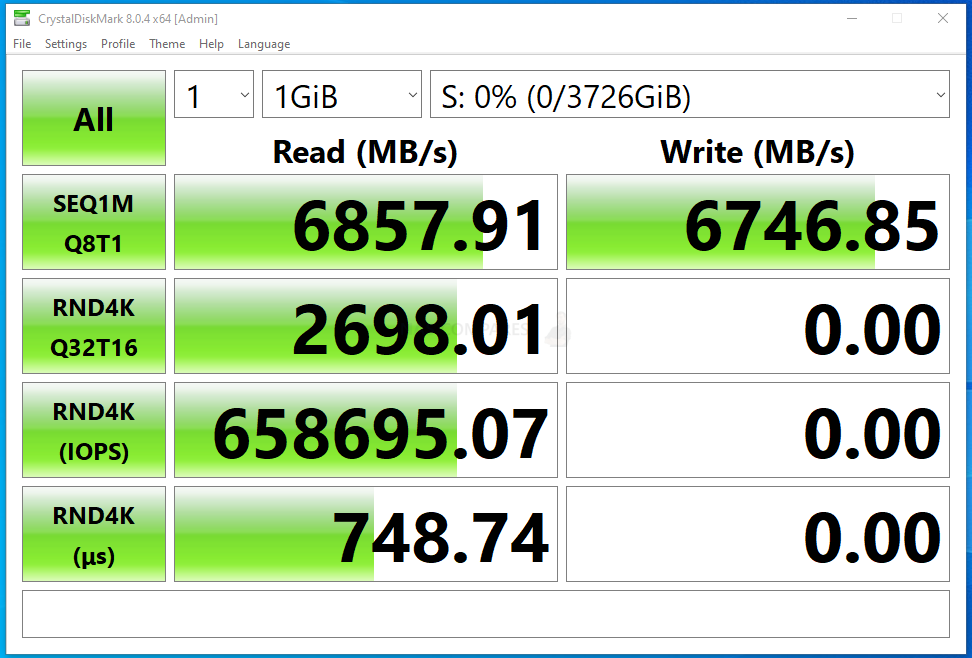
Although this never crossed into the 7,000MBs mark (I suspect down to my test hardware), when I tested the 4GB test file routine, we saw increased benchmark scores 6,979MB/s Read and 6,741MB/s Write, as well as increased IOPS reported.
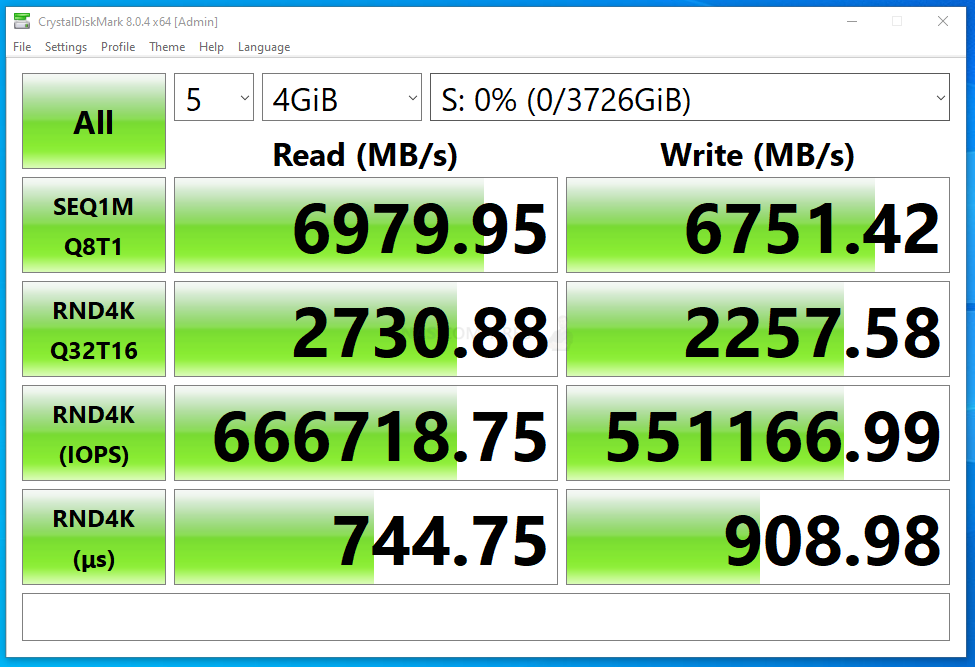
Ordinarily, I would introduce tests like BlackMagic and AJA into the mix here, but even a short burst of testing on an NVMe like this would over saturate the cache memory n board. Nevertheless, in the short term we still could ascertain the reported performance of 5,947/5,405MB/s on 16GB file testing:

Overall, the Sabrent Rocket 4 Plus was certainly able to provide some solid performance, as well as potentially exceed the test figures here on a more powerful machine. Given the reported Read and Write statistics that the brand has stated publically, I think there is enough evidence here to back up those claims.
Sabrent Rocket 4 Plus SSD Review – Conclusion
There is no denying that the Sabrent Rocket 4 Plus is an impressive SSD! Despite the wide range of solutions open to most SSD buyers, Sabrent has managed to do an incredible job of not only standing out from their contemporaries but also massively exceed them! Though it still lives marginally in the shadow of more expensive SSDs, like the Seagate Firecuda 3530, it still manages to massively outpace a number of big releases from Samsung and WD in 2021. With a consistent Performance of 6.9GB/s performance in our test area, it is no slouch and although the IOPS ratings are less than man recent releases, it makes up for it with a better price point in the lower tiers. Indeed, it is quite hard for most home and prosumer users to fault the Sabrent Rocket 4 Plus. The warranty procedure could certainly do with a change in-house and the oddly imbalanced price vs TB price point will hopefully level out when shortages level out, but overall I am quite pleased with what the Sabrent NVMe SSD bring to the table and recommend to home users, gamers and professionals who want a single drive that does exactly what it says on the tin
| PROs of the Sabrent Rocket 4 Plus | CONs of the Sabrent Rocket 4 Plus |
| Genuinely Impressive Performance
PS5 Compatible One of the Affordable 7,000MB/s Drive on the Market Decent Amount of DDR4 Memory Cache 96 Layer 3D TLC NAND Hugely Beneficial One of the Earliest Phison E18 SSDs Surpasses Samsung/WD PCIe 4 SSDs in some key areas |
IOPS rating is noticeably lower than most competitors
Endurance (DWPD/TBW) has dipped noticeably since it’s predecessor Still Outperformed by the Firecuda 530 Warranty (1yr unless registered) seems needlessly complex |
🔒 Join Inner Circle
Get an alert every time something gets added to this specific article!
This description contains links to Amazon. These links will take you to some of the products mentioned in today's content. As an Amazon Associate, I earn from qualifying purchases. Visit the NASCompares Deal Finder to find the best place to buy this device in your region, based on Service, Support and Reputation - Just Search for your NAS Drive in the Box Below
Need Advice on Data Storage from an Expert?
Finally, for free advice about your setup, just leave a message in the comments below here at NASCompares.com and we will get back to you. Need Help?
Where possible (and where appropriate) please provide as much information about your requirements, as then I can arrange the best answer and solution to your needs. Do not worry about your e-mail address being required, it will NOT be used in a mailing list and will NOT be used in any way other than to respond to your enquiry.
Need Help?
Where possible (and where appropriate) please provide as much information about your requirements, as then I can arrange the best answer and solution to your needs. Do not worry about your e-mail address being required, it will NOT be used in a mailing list and will NOT be used in any way other than to respond to your enquiry.

|
 |


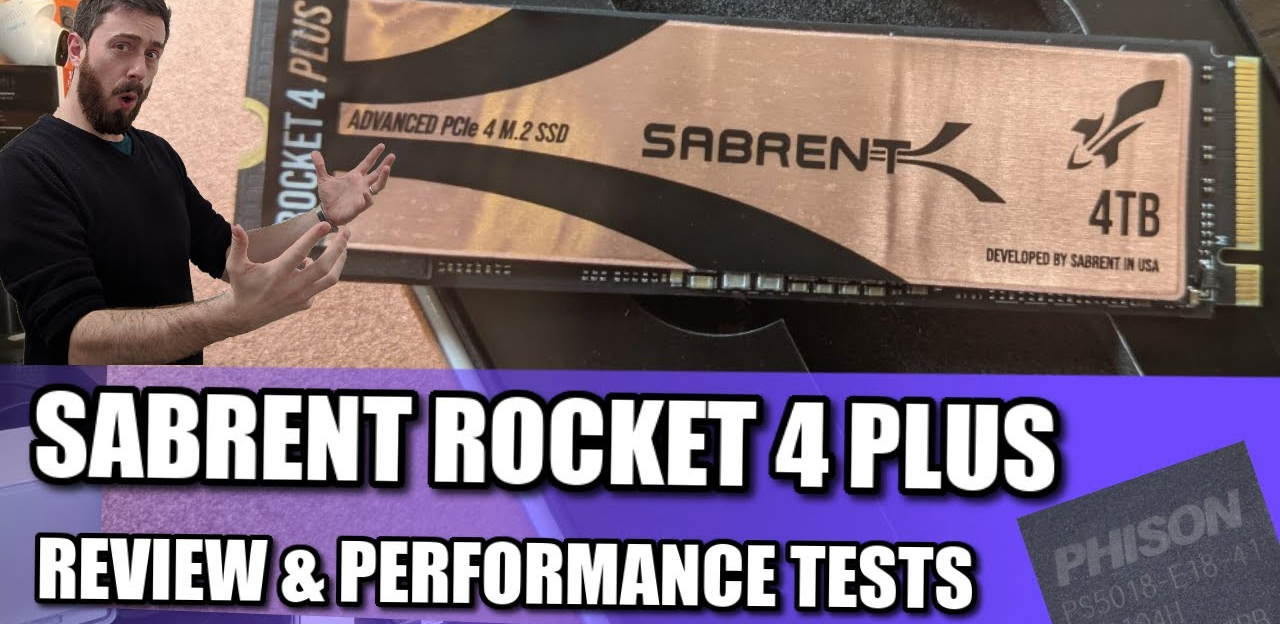


A really good & detailed video ????
REPLY ON YOUTUBE
Why people usually show load times only aren’t and weren’t doing this? These comparisons are right; it easily shows to me that M.2 reduces stutter and loads textures faster,ps5 is using a slower speed
REPLY ON YOUTUBE
Sorry but I could only click the like button once…… Great vid. I’m looking to find a suitable boot drive for my mac book pro and air. This may do the job. You video was clear and concise. I liked the part about the band width being the pipe. Very helpful. Using a Nvme drive as a boot drive is most likely old news ( I’m a pro photog that too busy to stop and research) but if you could make a video about the prior mentioned it would be grand. Best to you and yes I will subscribe.
REPLY ON YOUTUBE
gear
REPLY ON YOUTUBE
Fantastically helpful in-depth comparison thank you ???? Definitely a lack of videos and articles put there comparing storage hardware in depth.
Looking for new drives to use for project and cache drives for video/photo editing.
And you were correct the prices are very volatile. The Sabrent Rocket Plus has down a lot in price compared to your prices at the time of your video. The Seagate prices are about the same. Actually more expensive for the 2tb now.
REPLY ON YOUTUBE
Hi I’ve purchased a rocket nvme 4.0 m.2 ssd for my PlayStation 5 will this work ok
REPLY ON YOUTUBE
Mines not working…it says can’t use the ssd in the expansion slot..already tried 3x.. i’m using the sabrent rocket 4plus 2tb m.2 pcle gen4 nvme ssd…
REPLY ON YOUTUBE
Hi i just pre-ordered the sabrent ssd with heatsink, but i see in amazon endurance is not that good. Should i worry or cancel my order?
REPLY ON YOUTUBE
This a good video however, your test reflects the 500gb. If you test at least the 2 tb we will be able to see this ssd’s true performance. For example I’m currently using the 2tb of the sabrent rocket 4 plus on my PS5 and I get read speeds of 6658. ( the highest of seen on any ssd to date.) Please test the 2tb of the firecuda 530 for the ps5. Test games like red dead redemption 2, gta 5, cyberpunk ect…games with the longest load times.
REPLY ON YOUTUBE
If one could get the Sabrent for cheaper then the WD SN850. Would you advise to get the Sabrent over the WD?
REPLY ON YOUTUBE
i own 3 2 tb rocket those tings are awesome nad getting another for my ps5
REPLY ON YOUTUBE
Forget what is more expensive, it’s still ludicrous to pay £400+ for a 2TB. I say 2TB because that has to be the minimum at this point, because of the size of games (PS5). 500GB would be viable for those that have PC’s and are adding a second NVME.
I still say, stick it out and wait for the 530 4TB to come down in price. It will be a long wait but worth it in the end.
REPLY ON YOUTUBE
What good is buying a fast car if the engine dies within a short time? The Aorus performs better than these 2 in the long run. The durability question is should I pay more for less durability. Look up the real amazon reviews of everyday people and look at their personal experience on how long they lasted before failing. Seagate is overpriced for lack of durability.
REPLY ON YOUTUBE
will the 4T FireCuda 530 with EKWB Heatsink fit PS5 ?
REPLY ON YOUTUBE
UPDATED – Recommended PS5 Compatibile SSDs & Heatsinks – https://nascompares.com/2021/08/03/recommended-ps5-compatibile-ssds-heatsinks-updated/
REPLY ON YOUTUBE
tryna hook me up w that drive????? need that for my ps5????
REPLY ON YOUTUBE
Thaks for the heads up!
REPLY ON YOUTUBE
So does the Sabrent SSD and heatsink fit in the PS5 expansion slot??
REPLY ON YOUTUBE
Why is this so important?
REPLY ON YOUTUBE
Very tempting to get an sn850 but I’ll probably get one towards the end of this month or towards the middle of september so I can return it if it doesn’t work
REPLY ON YOUTUBE
So just to Confirm NVMe does not come with any kind of Heatsink..
REPLY ON YOUTUBE
The registration is designed to harvest contact information.
REPLY ON YOUTUBE
I wrote 7 months ago on this channel to get 980 pro they told me to wait for Sony now u people see it works like I said
REPLY ON YOUTUBE
The 5 year warranty registration is all about getting your personal data.
REPLY ON YOUTUBE
I’m curious which ssd m.2 nvme have in mind to buy? my choice so far is GIGABYTE AORUS 7000s PCIe 4.0 NVM. But i’m just waiting for offiecial list
REPLY ON YOUTUBE
I’m all up for 4TB SN850, don’t care about the price. Just want full experience without ounce of patience.
Edit: I also recommend M.2 heatsink from Silverstone. It give constant 31 degrees and the temp will drop by 2 degrees after replacing stock thermal pad into Thermalright Thermal Pad 1mm. Planning to get Fujipoly Extreme Pad.
REPLY ON YOUTUBE
The SSD cooling block does fit in the PS5, just make sure the standoff is being used UNDER the SSD and not on top of the SSD
REPLY ON YOUTUBE
It only makes sense that SeaGate has the better drive because they released it almost a year later lol.
REPLY ON YOUTUBE
Sabrent Rocket 4 Plus
Write speed: 7100mb
Read speed: 6600mb
Fire Cuda 530
Write speed: 7300mb
Read speed: 6900mb
The main difference between these two drives is not speed at all it’s the amount of write endurance the Fire Cuda has over Sabrent. Which means much greater drive longevity. In terms of real world performance they should be identical. These are both the best SSD’s on the consumer market.
REPLY ON YOUTUBE
Did you make sure the Sabrent Rocket Plus is running the firmware 1.2 fix?
REPLY ON YOUTUBE
Get a mic
REPLY ON YOUTUBE
If you want to talk about IOPS, would you talk about QD1 IOPS? I think it’s more relevant to single user use cases.
REPLY ON YOUTUBE
So which ones will be cheaper for the ps5 but remain constant at read for games?
REPLY ON YOUTUBE